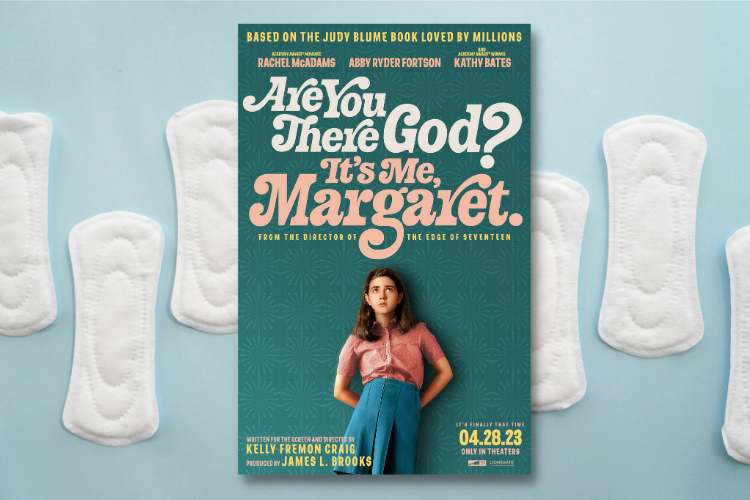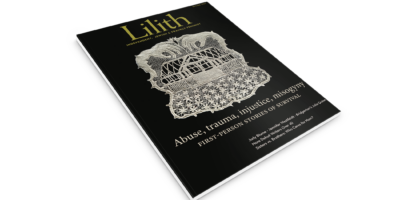
Zooming with Judy Blume
The moment I heard that the film adaptation of Are You There, God? It’s Me, Margaret was, finally, imminent, I sprang into action. My pitch to my editor was impassioned: I grew up interfaith, with a Jewish father and Christian mother, and got my first period in the middle of attending Mass with a deeply devout middle school friend. I received a copy of Are You There, God? from my mother when I started middle school, and the spine quickly developed a crack from frequent re-reads. But all of this isn’t, I recognize, unique. Bringing Margaret to the screen is a big deal precisely because Judy Blume has managed, across generations, to make every reader feel intimately seen by and connected to one of her most famous protagonists. Almost everyone I knew growing up—Catholic, Jewish, and Otherwise—had a copy of Margaret on their shelf. And everyone I knew with Margaret on their shelf went on to have their first period—each experience more horrifying and wonderful and comedic and tragic than the last.
Still, I am enchanted by the idea of getting to speak any combination of words to Blume, even if it’s one of dozens of similar conversations she’s undoubtedly agreed to ahead of the film’s release. When the Zoom room loads, it’s not Judy sitting in the chair, but her husband, making sure the sound levels are right. “Okay,” he says, standing up and waving his hands. “Three… two… one… here’s… Judy!” And suddenly, there she is, on my screen and peering into the camera: the same face gracing my copies of Deenie, Forever…, and Then Again, Maybe I Won’t. I am temporarily stunned by literary celebrity: my first few questions are mumbled and weakly offered. But Blume is a consummate professional. She is matter-of-fact in every respect. She doesn’t ramble, nor expand for the sake of expanding. She doesn’t use filler words. When she says something is like something else, a proper simile follows. “I read that in between editions of Are You There God? It’s Me, Margaret they changed the references of belted sanctuary pads to adhesive ones,” I venture. Blume quickly corrects me: “There is no they—I approve of every change.” I’d feel chastised, if I weren’t so wholly impressed. We get back on track: Are you familiar with some of the chatter that’s taken place regarding updated covers of the book? I saw an updated edition with iPhone text message bubbles, as if Margaret was texting God. I remember seeing backlash against this cover—like it was getting away from the “heart” of the book. Do you have any feelings about the various iterations the covers have gone through? Blume sits with this for a moment, then smiles, mostly to herself. She seems bemused I’d even ask. The covers have been changing since the book came out! There have been probably twenty different covers over the last fifty years, and that’s not counting the foreign editions…there are Margaret purists out there, they want the same cover they grew up with, and the original mention of the belted pads…I don’t get involved in those conversations, I don’t take sides. This strikes me as eminently fair. I’ve looked for versions with the belts mentioned, I tell her. She waves her hand. There are a lot of first editions out there, you can find one. Which one did you have? Finally! Mine was blue, with a little cutaway cover, and a bra in the keyhole. For half a moment, I worry she won’t remember my copy, in the tidal wave of editions that have come out in the last fifty years. Oh, she says, laughing. Oh, I hated that one! I start laughing, too.
I ask her what felt most essential about her protagonist Margaret Simon to transfer to the screen in the first-ever adaptation of Are You There, God? It’s Me, Margaret. She answers quickly. “You know, I don’t know,” she says, and I find myself surprised. I try again: “What’s the core of the story?” Blume is nonplussed. “I don’t know if there’s a “core” to Margaret, or what it is…I just wrote, and it was intuitive.” But then she smiles: “I didn’t know what I was doing when I wrote it,” she says, and laughs. “I was young. But Kelly [Fremon Craig] has made a movie that I like very, very much.” She clasps her hands together as she says very, very much. Later, in a follow-up email, she adds, “Her core, her essence to me, is that she’s a thinking, feeling, 12-year-old girl, a girl on the cusp. She’s at the age when she’s beginning to see her parents as people, not just as mom and dad. She’s beginning to question everything.”
Was she involved in the script, or casting? She shakes her head. “Kelly brought me the scripts, I didn’t write them. And I tried to stay out of it. There was one moment where I stepped in and said, no, no, it looks like this, you know, with the—[pumps arms back and forth to the side] “we must, we must, we must increase our bust,” they were doing it more like [presses hands together in a prayer position in front of her chest]… Kelly and Jim were beyond inclusive from the start, with the screenplay as Kelly was writing it, with the casting and then, inviting me to the set…I knew then, watching Kelly direct the scenes, watching her confer with Jim, that she was getting it right.” I tell her that when I read the book, I always envisioned Margaret and her friends’ breast exercises the way she demonstrated them. “Yes!” she exclaims. “Yes! But Kelly told me when she read the book, she pictured it her way, in the front, so.” “You know,” I venture, “I did those exercises, just for the hell of it. I knew from the way you wrote the book that they wouldn’t do anything for me, but…” We both laugh, and I am thrilled to have offloaded a secret puberty-related shame of mine onto a beloved childhood writer.
I didn’t realize how nervous I was to see Margaret in motion until my screener was whirring to life. The movie is one of the best I have seen in a long time: precisely the right tone, for precisely the right moment. “There were moments in watching it where I just…we burst out…laughing. I could see you thought I was going to say crying!” Blume told me (and she was right). “In the scene where Nancy demonstrates to Margaret how to practice kissing so when the time comes she’ll be ready, Margaret watches, you can see her trying not to laugh, then suddenly she can’t hold it in any longer. It feels totally spontaneous, but Kelly told me they’d actually worked on that scene for a long time.
“There are so many moments like that. It’s a funny movie, not jokey-funny, but organically funny. The humor grows out of the characters. The first time I saw it I cried from beginning to end. It was just so emotional for me to see these characters I created fifty-plus years ago come alive on the screen. There are scenes that still get me every time. My husband and I both tear up when Margaret’s mom tells her why her parents disowned her. And when Margaret begins to doubt God because all three of her grandparents behave badly, we’re feeling what she’s feeling—confused and angry and not knowing what or who to believe.” Indeed, the film’s treatment of Margaret’s religious exploration is deft and true to her age. Despite the title, decades worth of think pieces about the book have generally focused less on Margaret’s relationship to God than on her journey through puberty. Perhaps particularly underappreciated is how Margaret’s interfaith upbringing is treated so normally (even if she doesn’t feel that it is). I suspect that for many, this book was the first that illustrated the existential questions interfaith kids have without getting bogged down in the details. More to the point: Margaret isn’t worried about whether or not Judaism and Christianity are fundamentally different theologically. What matters is feeling close and connected to both of her parents—and feeling like she belongs. It is profound that at no point in the text does someone tell Margaret that many Jewish people believe in a strictly matrilineal interpretation of Jewish identity. She just wants to know whether she should join the Y or the JCC.
Margaret cuts through the noise, and speaks directly to God. Blume concurs: “There have been so many kids writing to share their interfaith backgrounds. I think they were surprised and pleased to find a book that they felt was written just for them… There’s even more intermarriage today. Most kids just want to know where they belong. They don’t want it left up to them to decide and neither does Margaret.”
I ask Blume if there’s anything she wants to add ahead of the film’s theatrical release. “It’s a miracle!” she exclaims. She squeezes her hands together, as she had before. “I like it very, very much.”
Justine Orlovsky-Schnitzler works in reproductive justice and earned her MA in Folklore in 2021. She’s interested in abortion rights and accessibility, labor organizing, and the demilitarization of the border.


